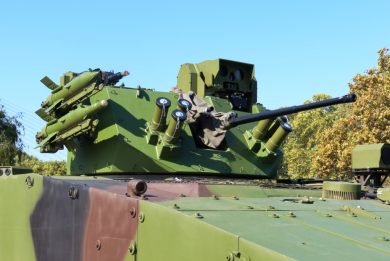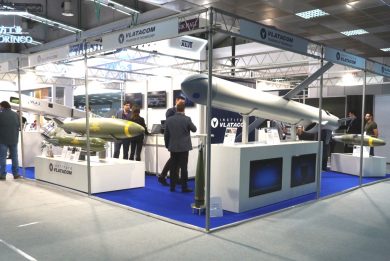
Partner 2023 – Upgraded Malyutka antitank missiles ready to join the Serbian Army
At Partner 2023 the Serbian Military Technology Institute provided new details on the upgrade of the Malyutka antitank missile, the first one of the three types under development being now ready to join the Army
Mock-ups of all three versions of Malyutka missiles currently being upgraded by the Military Technology Institute (MTI) military and civilian engineers were visible on some of the exhibited combat vehicles at the Belgrade Exhibition Centre. However only one of them has currently entered the initial production phase, the other two being still in development.

The one ready to join the forces is the Malyutka 2F, which is fitted with a new 2.5 kg thermobaric warhead capable to generate an overpressure of 0.3 bars at 7 metres distance from the centre of the detonation. Here MTI engineers worked mostly on the warhead itself, in order to improve its lethality. However also the missile guidance system was upgraded, from manual (MCLOS) to semi-automatic command to line of sight (SACLOS); with the MCLOS the operator had to guide the missile towards the target using a joystick, while in the SACLOS version he must keep the crosshair on the target and the missile will follow, a much simpler operation, especially when under stress on the battlefield. Although this does not make the Malyutka a modern generation missile, it however considerably increases its combat effectiveness. The Malyutka 2F has a minimum operating range of 500 metres, maximum range being 3 km, the time to target at the maximum range being under 30 seconds as the flight speed is around 110 m/s. The missile diameter is 125 mm while the span of the rear cruciform wing set is 393 mm. With a length of 800-900 mm, the Malyutka 2F has a weight at launch of 12-13 kg.

These data apply also to the Malyutka 2T model with tandem warhead, with the exception of length, which is 1,000-1,100 mm, and weight 12.5-13.5 kg. Beside the adoption of the SACLOS guidance, here too the main upgrade was done on the warhead. New technologies allow considerably increasing penetration capacity at the same shaped charge diameter. According to data provided, the Malyutka 2T is able to penetrate over 800 mm rolled homogeneous armour (RHA) after defeating the explosive reactive armour (ERA) layer with the precursor charge located at the very front end of the missile.

The adoption of the new warhead led to a weight increase of over 1.5 kg; to ensure the necessary thrust a more energetic propellant had to be adopted, while keeping the motor identical. The new propellant, that EDR On-Line understood being used in all three upgraded Malyutkas, was developed by Milan Blagojević Lučani.
The Malyutka 2T is in the very final stage of development, prototypes having already been test fired. According to MTI representatives two different noses have been developed, to reduce drag, selection of the production one to be probably done after full testing.
While the two previously described Malyutka maintain the 3 km maximum range, this will not be true for the last one of the missiles under development at the MTI. Here the Serbian Army gave to the institute engineers the task to develop the Malyutka in a much more radical way, making it a 5 km range radiofrequency-guided weapon.

The original Malyutka is fitted with two motors, a booster capable to accelerate the missile at launch, and a sustainment motor functioning for a longer period to maintain the speed until the missile reaches the target at maximum range. The range requirement being increased by two thirds, it is clear that military and civilian engineers working at MTI had to adopt a radical reshuffling of the propulsion system. And this is what they did, doubling the number of motors in the missile, which has obviously become much longer and heavier, 1,700 mm and 26 kg. Not only, to cope with the penetration requirement, over 900 mm RHA behind ERA, the shaped charge diameter was increased, making in fact what is known as Malyutka 2T-5 a new missile. The precursor warhead is the same used in the 2T, while the main shaped charge is a fully new development, its diameter being 142 mm, while the missile diameter remains 125 mm.
Starting from the rear we first find the original sustainment motor which nozzle is at the back of the missile. The wire reel has been removed as the new missile is RF-guided, no information on where the RF link is located being available. Moving towards the front we then find the original booster, which nozzles can be seen on the missile body. This is followed by the add-on sustainment motor, which nozzles are also visible; EDR On-Line understood this ensures a thrust of 20 decaNewton for 25 seconds. A “bump” can be seen moving forward; the change of diameter indicating that this section hosts the main warhead. The aft section is dedicated to the precursor charge, a set of small canard wings being fitted to the nose for balance purposes, according to information obtained at the exhibition. MTI engineers underlined that one of the most critical issues is the optimisation of the precursor and main charges.
As said the insertion of the two extra motors increased the length, while the wingspan remains 393 mm. Adding propulsion meant increasing speed, which is now around 200 m/s, the time to target being therefore maintained under 30 seconds.
The requirement calls for a maximum range of 5 km and one of 4.5 km against moving targets; EDR On-Line understood the 4.5 Km mark has been achieved, a final effort being needed to add the half kilometre that is still lacking. Minimum shooting distance is 750 metres. Reliability has also to be improved, tests having been carried out with very first development missiles. The Serbian Army asked for an 80% hit probability against static targets and 60% against moving targets. No in-service date was provided.
The Malyutka upgrade which is being carried out will allow Serbia to deploy a family of missiles representing a credible threat for potential enemies, at controlled cost.
Photos courtesy P. Valpolini



